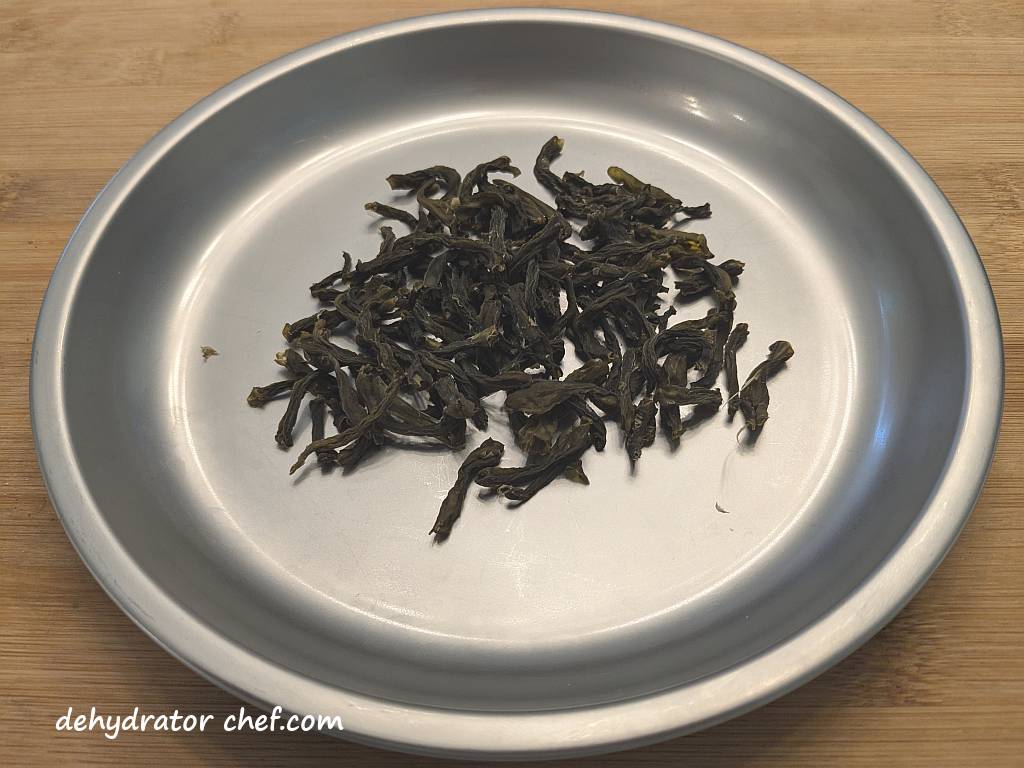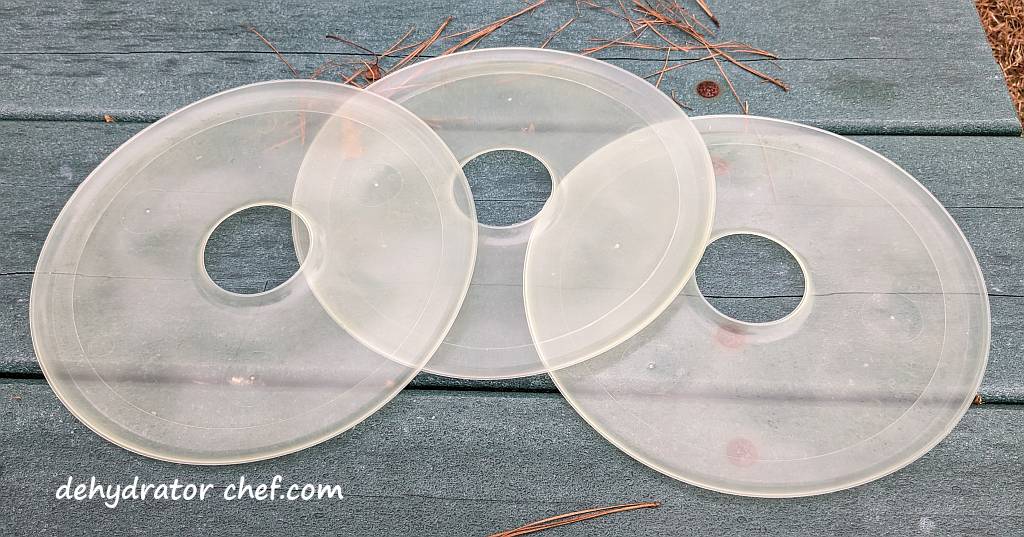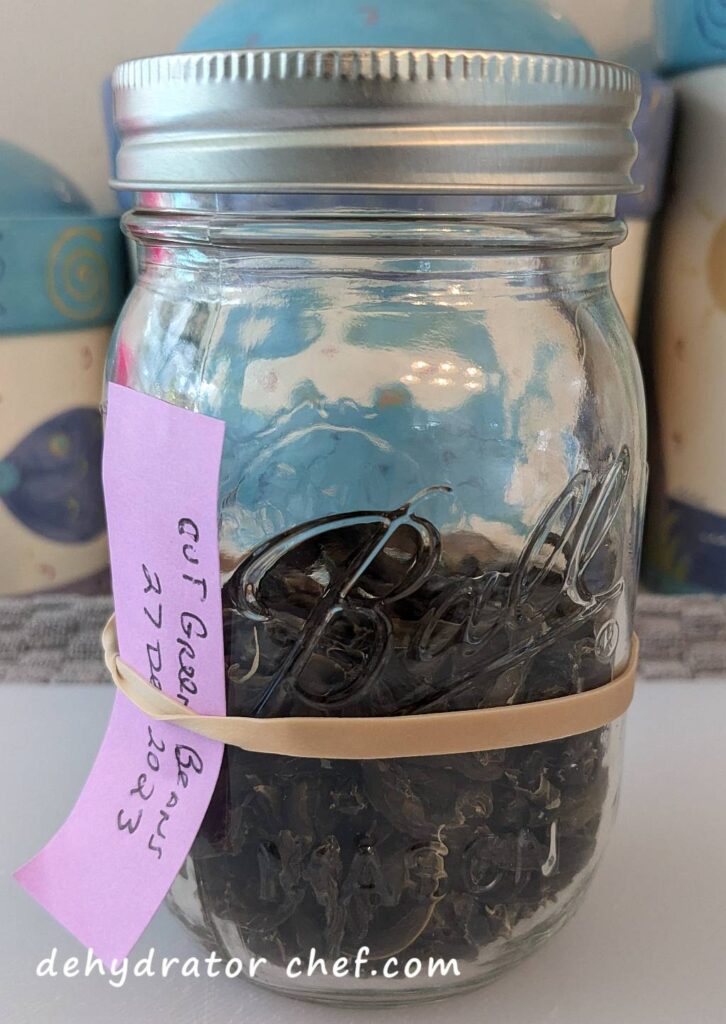This is our step-by-step guide on how to dehydrate green beans. We’re dehydrating canned cut green beans today.
Dehydrating canned cut green beans is a simple process that can help make your homemade dehydrated camping meals even more enjoyable by adding even more variety and options.
By dehydrating canned green beans, they become lighter, take up less space, and have a longer shelf life. More importantly, dehydrated, canned green beans make them rehydrate and cook much faster in our dehydrated camping meal recipes.

Even if you’ve never dehydrated anything before, don’t worry; dehydrating canned green beans is a simple process that anyone can do with just a few basic tools that we will discuss here.
So let’s get started dehydrating green beans.
Table of Contents
- How to Dehydrate Green Beans
- Supplies Needed for Dehydrating Green Beans
- Step 1. Process the Canned Green Beans for Dehydration
- Step 2. Preparing the Dehydrator for Dehydrating Green Beans
- Step 3. Dehydrating the Canned Green Beans
- Step 4. When are the Dehydrated Green Beans Done
- Step 5. Equalizing and Conditioning of the Dehydrated Green Beans
- Step 6. Storing Dehydrated Green Beans
- Hydration
- Weights, Measures, and Serving Sizes
- Dehydrated Green Bean Nutrition Information
- Insider Tips
How to Dehydrate Green Beans
All you need to dehydrate these foods is a good quality food dehydrator. We use the Nesco food dehydrators. You can check out our food dehydrator guide to learn why we think Nesco offers the best bang for the buck. We believe this is the best food dehydrator for our long-term food storage needs.
First, we should talk about dehydrating canned green beans versus dehydrating frozen green beans. What makes one option better than the other, and why?
Our primary consideration is the rehydration time; how long does it take for the dehydrated green beans to absorb enough water to become soft enough to eat?
Reconstituting Dehydrated Canned Green Beans
Canned green beans have been cooked. The advantage of using canned green beans in our Dehydrator Chef homemade dehydrated camping meal recipes is that they quickly reconstitute at the same rate as other ingredients, typically around 15 to 20 minutes.
When vegetables are subjected to heat during the cooking process, the pectin in their cell walls starts to break down. This breakdown of pectin causes the bonds between the cells to weaken, resulting in the softening of vegetables. As the pectin molecules break apart, water is released, further contributing to the soft texture.
The breakdown of the pectin enables cooked and dehydrated vegetables, like green beans, to reconstitute much faster than their uncooked counterparts.
Reconstituting Dehydrated Frozen Green Beans
Frozen green beans may have been blanched prior to freezing, but they have not been cooked. Sure, we can successfully dehydrate frozen green beans. However, reconstituting dehydrated frozen green beans into an edible state requires cooking and can take 30 to 45 minutes or longer. We’re not cooking anything that long on our small one-burner backpacking stove.
Supplies Needed for Dehydrating Green Beans
- Several cans of green beans, low to no-sodium preferred
- Food dehydrator, with removable fruit roll sheet inserts, one for each dehydrator tray
- Common kitchen tools, including cutting boards, colander, chef’s knife, spatula, etc.
- Clear canning jars with tight-fitting lids
- Wide-mouth canning jar funnel
- Desiccant packets (optional)
For planning purposes, one 14.5-ounce can of drained green beans will fill one Nesco 13.5-inch round dehydrator tray.

The Nesco 13.5-inch round dehydrator tray has close to 119 square inches or .8 square feet of surface area for drying.
Step 1. Process the Canned Green Beans for Dehydration
Open the can of green beans and empty the contents into a colander. We’ll need to rinse away the salty canning liquid. We all get too much salt in our diet. The USDA publication titled Effect of draining and rinsing on the sodium and water soluble vitamin content of canned vegetables, by D.B. Haytowitz, shows that sodium can be reduced between 9 and 23 percent by rinsing with warm tap water and then allowed to drain.

We’re also inspecting the green beans and removing anything that shouldn’t be there, such as woody stem pieces. Despite the use of modern food processing equipment, it is not always possible to remove all foreign materials. So, remove anything you wouldn’t want to eat.
Step 2. Preparing the Dehydrator for Dehydrating Green Beans
We will use these removable Nesco fruit roll sheet inserts on our food dehydrator for today’s project. They have over 3000 customer reviews with an average rating of 4.5 stars out of 5, which is evidence of a great product. Check out other Nesco food dehydrator products here.

Evenly spread and layer the green beans over the fruit roll sheet inserts. Ideally, one layer deep. Spread them out for better airflow and faster dehydration. If it gets too crowded, prepare another tray.

One 14.5-ounce can of cut green beans will fill one Nesco 13.5-inch round dehydrator tray with the removable fruit roll sheet insert.

Step 3. Dehydrating the Canned Green Beans
For canned green beans, set the dehydrator temperature to 135 °F (57 °C). I find that 18 to 24 hours is about the right amount of time. Use drying times only as a guide. Of course, drying times are variable and dependent on your food dehydrator and on the ambient temperature and humidity, how many, and how crowded you fill your dehydrator trays.

High summertime heat and humidity can lengthen the dehydration times, potentially doubling the times found here and in your owner’s manual.
Step 4. When are the Dehydrated Green Beans Done
The dehydrating green beans will tend to shrink up, shrivel, and wrinkle. If not, just let it all go for another couple of hours and check again.
When done, they should be hard and brittle. They will easily snap in half like a potato chip when bent.

Drying times will vary depending on your dehydrator. Refer to your dehydrator owner’s manual for recommended temperatures and times for dehydrating specific foods. Remember to use drying times as a guide.

With experience, you’ll develop an eye for this, but until it develops, just check it all for dryness.
Step 5. Equalizing and Conditioning of the Dehydrated Green Beans
When the dehydrated green beans are removed from the dehydrator, the remaining moisture may not be distributed equally among the pieces because of their location and position in the dehydrator. Equalizing and conditioning is a process for freshly dehydrated foods that ensures any residual moisture remaining in any piece is spread or equalized among all the other pieces in the batch. Let the dried green beans equalize and condition in the storage container for 7 to 10 days.

We always recommend letting food items cool completely after they have finished dehydrating and before packing them into an airtight storage container for equalizing and conditioning. Warm food may cause sweating, which could provide enough moisture for mold to grow.
It does not take long for dehydrated food items to start hydrating from ambient household humidity. Do not leave dehydrated food items exposed to the elements any longer than necessary because of the increased risk of mold growth.
After a short cooling period, loosely pack the dehydrated green beans into a clean, dry, insect-proof, and air-tight storage container. Since the canning jars are clear, it’s easy to see what’s inside.
A wide-mouth canning jar funnel is handy for the task of getting dehydrated food from the trays into the canning jars with minimal spillage. It’s not a necessity, but having one does make the job easier and faster. If you need one, check them out on Amazon.
Every day, check the jar for moisture. Roll the jar contents around and note any clumping or sticking. If seen, put the contents back on the dehydrator for several more hours. Since canning jars are clear, it’s easy to see what’s inside.
In the unlikely event you notice any mold at all, even the smallest bit, throw it all out. What you see are the mold spores finally blooming enough to make them visible. But there are more, even tinier mold spores in the rest of your jar that make your dehydrated food inedible. Toss it out and start another batch.
Step 6. Storing Dehydrated Green Beans
Use an appropriately sized canning jar for storage. The dehydrated green beans might keep up to 12 months or longer. Exactly how long depends on how well you dehydrate the canned green beans and your pantry storage conditions.

We’ll use a food-safe desiccant packet for moisture control because we live in a fairly humid area. For our pint-size or quart-size mason jars, we’ll use a single food-safe 5-gram desiccant packet. The desiccant packets will absorb any moisture and extend the shelf life of the dehydrated rice.

We use these inexpensive food-safe desiccant packets, which are available from Amazon. These 5-gram packets have over 5000 of mostly 4- and 5-star customer reviews, with an average of 4.7 stars out of 5. Our bag of 60 desiccant packets will last quite a while because they can be recharged and reused multiple times. Other food-safe sizes are available.
Lastly, I’ll attach or include a short note describing the jar contents and the date the product was dehydrated. The label identifies the canning jar contents, and the date helps with the rotation schedule. A first-in, first-out rotation helps us to use items that have been on the shelf the longest, so we’re using the oldest food first. This method helps us maintain the integrity of dehydrated products. The note also lets me know where to go in my dehydrator logbook if I want to make another note or two.
Hydration
Hydrate the dried green beans using roughly a 3-to-1 or 4-to-1 ratio of dehydrated product to boiled water. Plan on at least 15 to 20 minutes to fully hydrate.
Weights, Measures, and Serving Sizes
This information is summarized from the notes we keep on most of our food dehydration efforts.
A 14.5-ounce can of cut green beans, about 3.5 servings, drained and rinsed, will dehydrate to approximately 17 grams. We’ll round the serving count down from 3.5 servings to 3 servings to make the math easy. So, each serving of dehydrated green beans is about 5 grams.
Dehydrated Green Bean Nutrition Information
Serving Size: 5 grams | Calories: 15kcal | Total Fat: 0g | Saturated Fat: 0g | Cholesterol: 0mg | Sodium: 290mg | Carbohydrate: 3g | Dietary Fiber: 1g | Sugar: 1g| Protein: 1g
NOTE: The product’s ingredient list includes added salt. It is assumed that some, but not all, of the sodium would be drained away with the canning liquid.
 | The Dehydrator Chef Book Available only on Amazon.com You’ll find step-by-step instructions for 26 homemade dehydrated camping meals. Many recipes are only available in this book. Grab yourself a copy today. |
Insider Tips
Besides dehydrated meal recipes found here on this website, add dehydrated green beans to any of your favorite freeze-dried food pouches for a bit more bulk and calories. I don’t know about you, but with some of those store-bought freeze-dried meals, I am still hungry. I need a bit more to fill me up.
Just be sure to compensate by adding additional boiled water in roughly a 4-to-1 ratio of added dehydrated green beans to boiling water to the freeze-dried meal and allow enough time for adequate hydration.
Practice at home making dehydrated camping meals using the very same gear used in the field. We practice reinforcing the skills we have learned. Practice makes perfect.

How to Dehydrate Green Beans
Equipment
- Removable fruit roll sheet insert (one for each dehydrator tray)
- Common kitchen tools (including cutting boards, chef's knife, strainer, can opener, etc.)
- Canning jars with tight-fitting lids
- Desiccant packets for moisture control (optional)
Ingredients
- several cans cut green beans (no-salt or low-sodium products preferred)
Instructions
Process the Canned Green Beans
- Drain, then rinse off the canned green beans with lukewarm water to help remove residual salty canning liquid.

Prepare the Dehydrator
- Layer the green beans onto the dehydrator tray lined with a removable fruit roll sheet insert; one 15-ounce can will fill one Nesco 13.5-inch round dehydrator tray. If it's too crowded, prepare another tray.

Dehydrate the Green Beans
- Set the dehydrator thermostat temperature to 135 °F (57 °C). Dry for 18 to 24 hours until done.

When are the Dehydrated Green Beans Done
- When done, the dehydrated green beans are hard and brittle. They will easily snap in half like a potato chip when bent. There should be no wet or mushy pieces.

Equalizing and Conditioning Dehydrated Green Beans
- After a short cooling period, loosely pack the dehydrated green bean pieces into a clean, dry canning jar with a tight-fitting lid, leaving some headspace.

- Every day, for 7 to 10 days, check the jar for moisture. Roll the jar contents around and note any clumping or sticking. If seen, put it all back on the dehydrator for several more hours.
- If you notice any mold at all, even the slightest bit, throw it all out.
Storing the Dehydrated Green Beans
- Use appropriate-sized canning jars for storage. Depending on how well you dehydrate them and your pantry storage conditions, the dehydrated green beans should keep for at least 12 months.

- An optional food-safe desiccant packet will aid with moisture control.

- Attach or include a label describing the jar contents and the date the green beans were dehydrated. The label identifies the canning jar contents, and the date helps with the rotation schedule. A first-in, first-out rotation helps us to use items that have been on the shelf the longest, so we're using the oldest food first.
Notes
Nutrition
Nutrition information is only an estimate and may differ depending on the ingredients you use.
